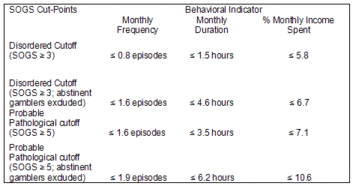The WAGER 13(5) – After Gambling Treatment, Is It Possible To Know When to Say When?
A number of longitudinal studies have determined that, after treatment, a proportion of pathological gamblers are able to gamble in moderation without relapsing (e.g., Abbott, Williams, & Volberg, 2004; Hodgins, Currie, el-Guebaly, & Peden, 2004; Ladouceur, 2005). However, little is known about how posttreatment gambling behavior relates to the return of gambling-related problems. This week’s WAGER reviews a study of posttreatment gambling behavior.
Petry and colleagues (2006) recruited individuals via local media advertising to participate in a study of gambling treatments (see Petry et al., 2006 for treatment results). Weinstock, Ledgerwood and Petry (2007) then conducted 12-month follow-up assessments with 178 of the original participants (77.1% response rate). Follow-up consisted of questions regarding demographic information, the South Oaks Gambling Screen (SOGS, Lesieur & Blume, 1987), and the Gambling Timeline Followback (GTFB, Hodgins & Makarchuk, 2003; Weinstock, Whelan, & Meyers, 2004), a calendar-based self-report record of gambling activity.
Using responses to the GTFB, Weinstock, Ledgerwood, and Petry (2007) created three variables of gambling behavior: monthly gambling frequency, monthly gambling duration, and percentage of monthly income spent gambling. They calculated cutoffs for each behavior based on receiver operator characteristic curve analyses that maximized both sensitivity and specificity. First, they compared the behaviors of problem-free gamblers (SOGS scores = 0) with those of symptomatic gamblers (SOGS scores ≥ 1). Second, they scrutinized the behaviors of symptomatic gamblers (SOGS scores 1-5). Third, they repeated analyses excluding participants who reported abstinence during the previous six months (n = 32).
Problem-free gamblers (n = 45; 30 of whom were abstinent) reported significantly fewer days of gambling (i.e., monthly frequency) than symptomatic gamblers (n = 133; Mproblem-free = 1.7, SD=5.6 vs. Msymptomatic = 6.3, SD=7.4) as well as significantly fewer hours per episode (i.e., duration; Mproblem-free = 3.5, SD=10.6 vs. Msymptomatic = 16.4, SD=21.2). Problem free gamblers also spent a significantly smaller percentage of their monthly income gambling (3.9%, SD=10.8) than that of symptomatic gamblers (73.9%, SD=202.1). Table 1 displays the potential behavioral indicators at two cut-points along the continuum: disordered gambling (SOGS ≥ 3; n = 118) and probable pathological gambling (SOGS ≥ 5; n = 95). The analysis indicates significant increases in monthly frequency and monthly duration, but only marginal increases in percent of income spent gambling, following the removal of abstinent participants.
Table 1. Gambling Behavior Indicators at Two SOGS Cut-Points (adapted from Weinstock et al., 2007)
This study is subject to several limitations. First, though the GTFB is supposed to limit these issues, problems associated with self-report, such as memory difficulties and recall bias, might have affected participants’ recounting of their gambling from the six months prior to follow-up. Second, all participants had completed a treatment program as part of a previous study. People who complete treatment might experience more favorable outcomes than those who do not. Because of the possibility that treatment might have contaminated this data, these findings might not be generalizable to other gamblers. Finally, the percentage of monthly income spent gambling reported here might not accurately reflect the spending behavior of all the symptomatic gamblers. The size of the standard deviation associated with spending (202.1) suggests the presence of a heterogeneous group, including extreme gamblers, compared to a more homogenous group of participants with more modest gambling behaviors.
This study examined the critical but previously unexplored relationship between gambling behavior and harm post gambling treatment. These findings suggest levels of gambling behavior (i.e., frequency and duration of episodes, percentage of income spent) at which previously treated probable pathological gamblers are able to gamble without recidivating. However, before developing guidelines for safe posttreatment gambling, we must realize that people do not divide into one group or another; people are not pathological or problem free. Posttreatment gamblers will slide between abstinence, moderation, and problem-gambling. Thus, it is impractical to create behavioral guidelines without considering this movement.
What do you think? Comments can be addressed to Sara Kaplan.
References
Abbott, M. W., Williams, M. M., & Volberg, R. A. (2004). A prospective study of problem and regular nonproblem gamblers living in the community. Substance Use and Misuse, 39(6), 855-884.
Hodgins, D. C., Currie, S., el-Guebaly, N., & Peden, N. (2004). Brief motivational treatment for problem gambling: A 24-month follow-up. Psychology of Addictive Behaviors, 18(3), 293-296.
Hodgins, D. C., & Makarchuk, K. (2003). Trusting problem gamblers: Reliability and validity of self-reported gambling behavior. Psychology of Addictive Behaviors, 17(3), 244-248.
Ladouceur, R. (2005). Controlled gambling for pathological gamblers. Journal of Gambling Studies, 21, 51-59.
Lesieur, H. R., & Blume, S. B. (1987). The South Oaks Gambling Screen (SOGS): A new instrument for the identification of pathological gamblers. American Journal of Psychiatry, 144(9), 1184-1188.
Petry, N. M., Ammerman, Y., Bohl, J., Doersch, A., Gay, H., Kadden, R., et al. (2006). Cognitive-behavior therapy for pathological gamblers. Journal of Consulting and Clinical Psychology, 74, 555-567.
Weinstock, J., Ledgerwood, D. M., & Petry, N. M. (2007). Association between posttreatment gambling behavior and harm in pathological gamblers. Psychology of Addictive Behavior, 21(2), 185-193.
Weinstock, J., Whelan, J. P., & Meyers, A. W. (2004). Behavioral assessment of gambling: An application of the timeline followback method. Psychological Assessment, 16(1), 72-80.
